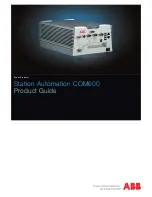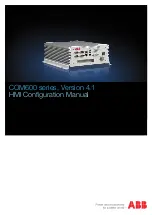
User's Manual
202
Document #: LTRT-10437
Mediant 500 E-SBC
15.4 LDAP-based Management and SIP Services
The device supports the Lightweight Directory Access Protocol (LDAP) application protocol
and can operate with third-party, LDAP-compliant servers such as Microsoft Active
Directory (AD).
You can use LDAP for the following LDAP services:
SIP-related (Control) LDAP Queries:
This can be used for routing or manipulation
(e.g., calling name and destination address). The device connects and binds to the
remote LDAP server (IP address or DNS/FQDN) during the service’s initialization (at
device start-up) or whenever you change the LDAP server's IP address and port.
Binding to the LDAP server is based on username and password (Bind DN and
Password). Service makes 10 attempts to connect and bind to the remote LDAP
server, with a timeout of 20 seconds between attempts. If connection fails, the service
remains in disconnected state until the LDAP server's IP address or port is changed. If
connection to the LDAP server later fails, the service attempts to reconnect.
For the device to run a search, the path to the directory’s subtree, known as the
distinguished name (DN), where the search is to be done must be configured (see
'Configuring LDAP DNs (Base Paths) per LDAP Server' on page
). The search key
(filter), which defines the exact DN to search, and one or more attributes whose values
must be returned to the device must also be configured. For more information on
configuring these attributes and search filters, see 'Active Directory-based Routing for
Microsoft Lync' on page
The device can store recent LDAP queries and responses in its local cache. The
cache is used for subsequent queries and/or in case of LDAP server failure. For more
information, see 'Configuring the Device's LDAP Cache' on page
If connection with the LDAP server disconnects (broken), the device sends the SNMP
alarm, acLDAPLostConnection. Upon successful reconnection, the alarm clears. If
connection with the LDAP server is disrupted during the search, all search requests
are dropped and an alarm indicating a failed status is sent to client applications.
Management-related LDAP Queries:
This is used for authenticating and authorizing
management users (Web and CLI) and is based on the user's login username and
password (credentials) when attempting login to one of the device's management
platforms. When configuring the login username (LDAP Bind DN) and password
(LDAP Password) to send to the LDAP server, you can use templates based on the
dollar ($) sign, which the device replaces with the actual username and password
entered by the user during the login attempt. You can also configure the device to
send the username and password in clear-text format or encrypted using TLS (SSL).
The device connects to the LDAP server (i.e., an LDAP session is created) only when
a login attempt occurs. The LDAP Bind operation establishes the authentication of the
user based on the username-password combination. The server typically checks the
password against the userPassword attribute in the named entry. A successful Bind
operation indicates that the username-password combination is correct; a failed Bind
operation indicates that the username-password combination is incorrect.
Once the user is successfully authenticated, the established LDAP session may be
used for further LDAP queries to determine the user's management access level and
privileges (Operator, Admin, or Security Admin). This is known as the user
authorization stage. To determine the access level, the device searches the LDAP
directory for groups of which the user is a member, for example:
CN=\# Support Dept,OU=R&D
Groups,OU=Groups,OU=APC,OU=Japan,OU=ABC,DC=corp,DC=abc,DC=com
CN=\#AllCellular,OU=Groups,OU=APC,OU=Japan,OU=ABC,DC=corp,DC=a
bc,DC=com
The device then assigns the user the access level configured for that group (in
'Configuring Access Level per Management Groups Attributes' on page
). The
location in the directory where you want to search for the user's member group(s) is
configured using the following:
Summary of Contents for Mediant 500 E-SBC
Page 2: ......
Page 16: ...User s Manual 16 Document LTRT 10437 Mediant 500 E SBC This page is intentionally left blank...
Page 22: ...User s Manual 22 Document LTRT 10437 Mediant 500 E SBC This page is intentionally left blank...
Page 23: ...Part I Getting Started with Initial Connectivity...
Page 24: ......
Page 26: ...User s Manual 26 Document LTRT 10437 Mediant 500 E SBC This page is intentionally left blank...
Page 28: ...User s Manual 28 Document LTRT 10437 Mediant 500 E SBC This page is intentionally left blank...
Page 33: ...Part II Management Tools...
Page 34: ......
Page 36: ...User s Manual 36 Document LTRT 10437 Mediant 500 E SBC This page is intentionally left blank...
Page 64: ...User s Manual 64 Document LTRT 10437 Mediant 500 E SBC This page is intentionally left blank...
Page 82: ...User s Manual 82 Document LTRT 10437 Mediant 500 E SBC This page is intentionally left blank...
Page 89: ...Part III General System Settings...
Page 90: ......
Page 106: ...User s Manual 106 Document LTRT 10437 Mediant 500 E SBC This page is intentionally left blank...
Page 107: ...Part IV General VoIP Configuration...
Page 108: ......
Page 238: ...User s Manual 238 Document LTRT 10437 Mediant 500 E SBC This page is intentionally left blank...
Page 250: ...User s Manual 250 Document LTRT 10437 Mediant 500 E SBC This page is intentionally left blank...
Page 280: ...User s Manual 280 Document LTRT 10437 Mediant 500 E SBC This page is intentionally left blank...
Page 329: ...Part V Gateway Application...
Page 330: ......
Page 332: ...User s Manual 332 Document LTRT 10437 Mediant 500 E SBC This page is intentionally left blank...
Page 352: ...User s Manual 352 Document LTRT 10437 Mediant 500 E SBC This page is intentionally left blank...
Page 412: ...User s Manual 412 Document LTRT 10437 Mediant 500 E SBC This page is intentionally left blank...
Page 441: ...Part VI Session Border Controller Application...
Page 442: ......
Page 489: ...User s Manual 28 SBC Configuration Version 6 8 489 Mediant 500 E SBC...
Page 510: ...User s Manual 510 Document LTRT 10437 Mediant 500 E SBC This page is intentionally left blank...
Page 511: ...Part VII Cloud Resilience Package...
Page 512: ......
Page 521: ...Part VIII High Availability System...
Page 522: ......
Page 536: ...User s Manual 536 Document LTRT 10437 Mediant 500 E SBC This page is intentionally left blank...
Page 537: ...Part IX Maintenance...
Page 538: ......
Page 544: ...User s Manual 544 Document LTRT 10437 Mediant 500 E SBC This page is intentionally left blank...
Page 546: ...User s Manual 546 Document LTRT 10437 Mediant 500 E SBC This page is intentionally left blank...
Page 548: ...User s Manual 548 Document LTRT 10437 Mediant 500 E SBC This page is intentionally left blank...
Page 582: ...User s Manual 582 Document LTRT 10437 Mediant 500 E SBC This page is intentionally left blank...
Page 600: ...User s Manual 600 Document LTRT 10437 Mediant 500 E SBC This page is intentionally left blank...
Page 602: ...User s Manual 602 Document LTRT 10437 Mediant 500 E SBC This page is intentionally left blank...
Page 603: ...Part X Status Performance Monitoring and Reporting...
Page 604: ......
Page 654: ...User s Manual 654 Document LTRT 10437 Mediant 500 E SBC This page is intentionally left blank...
Page 655: ...Part XI Diagnostics...
Page 656: ......
Page 672: ...User s Manual 672 Document LTRT 10437 Mediant 500 E SBC This page is intentionally left blank...
Page 687: ...Part XII Appendix...
Page 688: ......
Page 914: ...User s Manual 914 Document LTRT 10437 Mediant 500 E SBC This page is intentionally left blank...
















































